Let’s start with some serious reading
I spend a lot of my free time on Substack reading newsletters from people all over the world. Two of my closest friends in Portugal write their missives on the platform. Nancy Whitman pens Expat in Portugal and Carol Wilcox writes Our Portugal Journey. Both women are serious, brave, courageous and fun and can tell you a lot about becoming an immigrant in these uncertain times.
For information about politics and history I read both Heather Cox Richardson’s Letters From an American. I also read Popular Information, written by Judd Legum.
Letters From an American focuses on today’s politics and includes footnotes documenting her writing. Ms. Richardson is a history professor and often links what is currently going on in America to our historical past.
Popular Information, in my opinion, is hands down the best investigative journalism in America. While Mr. Legum admits to being a progressive he says, “[he] …is committed to providing readers with the facts necessary to form their own opinions. There is no expectation that readers share my views.”
Now for the fun stuff
My fun and leisure list is by far the largest category of my reads, most of which includes newsletters about food, eating and travel. One of my favorites is Lickedspoon, by Debora Robertson. For me this newsletter is so special that I always take time to savor it.
I like to think that Debora and I have a lot in common. For starters we are both women, we both left our home country and became immigrants. She likes to shop for food, I like to shop for food. She likes to cook and I like to cook. She is remodeling a house, and I am remodeling a house.
But then the similarities start to dissipate. Let’s just say she committed to her new lifestyle – she still is an immigrant, somehow learned to speak semi fluent French, and cemented her decision by purchasing a home in the southwest of France. If you would like to read more about her, follow the link above.
So, what is my fascination with Debora? For me, she is a combination of Ina Garten and Martha Stewart without all the fussiness. She shops like a European, because she is one, buying what is in season and making the best quality food with what is available.
She also inspired me to label my recipes with hashtags, as in #summer, #fall, #winter and #spring so I don’t have to search for inspiration.
And when Debora published a recipe with persimmons, I knew I had to try it and then share it with you.
Persimmon, halloumi and walnut salad
We tried this salad for the first time in mid-December and were surprised and delighted by how good it tasted.
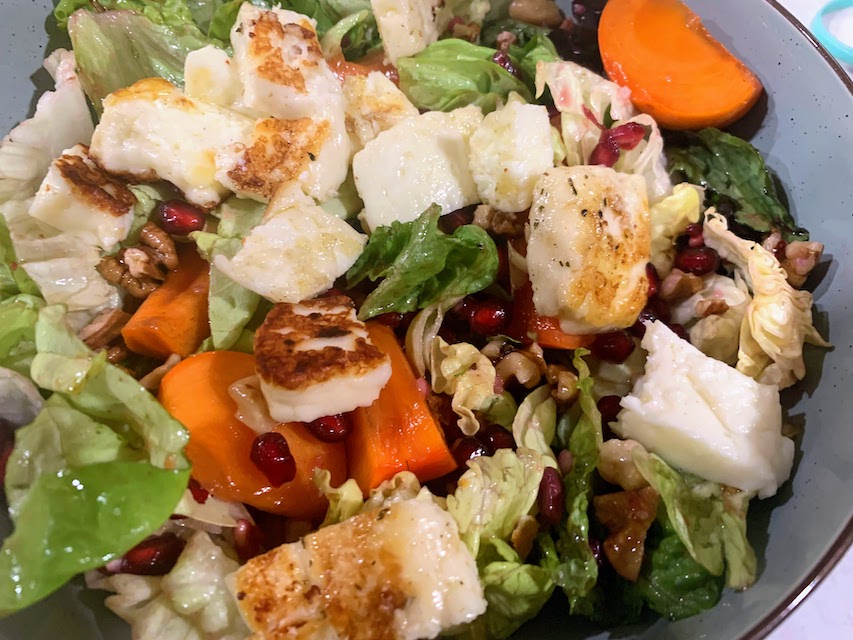
We’d been a little unsure about it, because it had two ingredients that we had never tried – persimmons and halloumi cheese. It’s been interesting to learn a little bit about both of them.
Persimmons are a small fruit, usually in season from October through December. They were originally grown in China, but are now grown in Japan, Korea, the United States, and Brazil. The fuyu persimmoon, shown at right, is the most common variety. They have a sweet flavor, and grow more sweet as they ripen.
Image credit: By © Frank Schulenburg, CC BY-SA 4.0
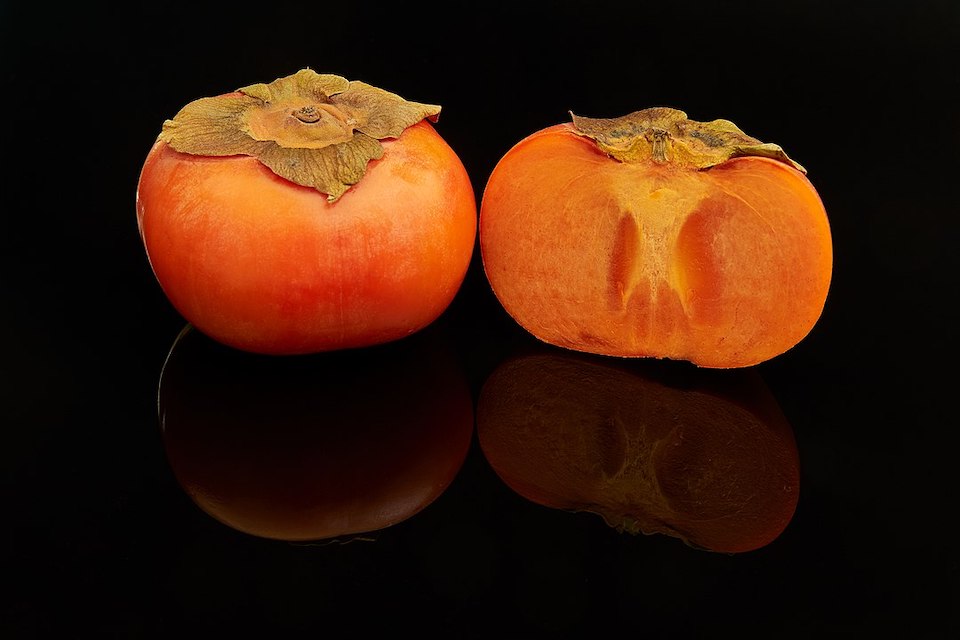
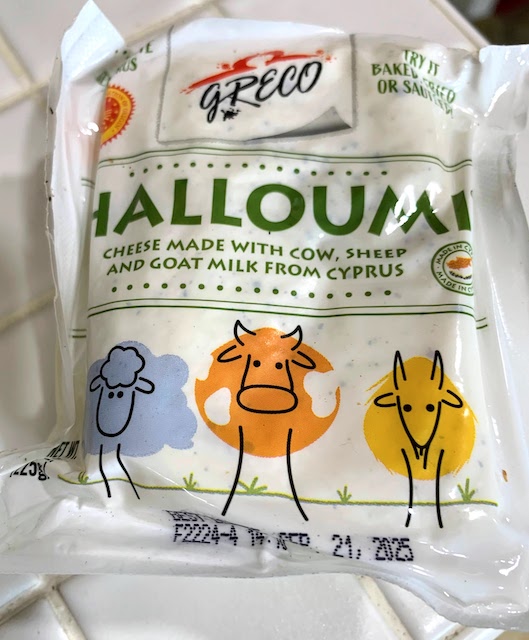
Halloumi cheese originated in Cyprus. It was traditionally made from goat’s milk, sheep’s milk, or a mix of the two. Today, cow’s milk is often included in the mix. The cheese has a consistency similar to mozzarella and a salty taste. It is known as a “grilling cheese” because it holds its shape when heated, with a crispy outside and a melty inside.
I wasn’t sure that I’d be able to find halloumi in our little Idaho town. Luckily, our local high-end grocery store stocked it.
Here’s the recipe.
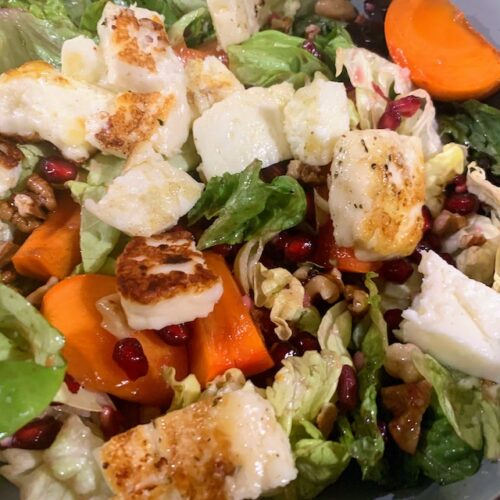
Persimmon, halloumi and walnut salad
Ingredients
For the vinaigrette
- 1 tbsp sherry vinegar or cider vinegar
- 1 tsp very finely chopped shallot
- 1/4 tsp runny honey
- 1 pinch chilli flakes
- 2 tbsp walnut oil or olive oil
- A few very fine gratings of zest from a clementine or orange – Pass the grater over the fruit once or twice, over the bowl where dressing is being made, being careful not to pare off any of the bitter white zest
For the salad
- 2 each persimmons – About 170g each, just beginning to ripen
- A couple handfuls mâche (lamb's lettuce) or watercress
- 80 – 100 grams pomegranate seeds
- 1/2 tbsp olive oil
- 1 package halloumi cheese, about 225g
- flaky sea salt
- 40 grams walnuts or almonds, toasted* – Roughly broken up with your hands
Instructions
- Put the shallot in a small bowl with the vinegar, zest, honey, chilli flakes and a pinch of salt and leave to sit for 10 minutes while the shallot softens and infuses the vinegar with its flavour.
- First prepare the persimmons. There’s no need to peel them. Simply cut out the stem and the white core then cut the slices into wedges. I aim for about 8 per fruit, depending on the size of the fruit.
- In a large salad bowl, combine the mâché or watercress with the pomegranate seeds, walnuts and sliced persimmons.
- Cut the halloumi lengthways into approximately 1.5cm slices. Warm a little olive oil in a small frying pan over a medium-high heat. Fry the halloumi until just golden, about 1 ½ minutes per side.
- Dress the salad with the vinaigrette and arrange some on each plate. Roughly tear or chop the fried halloumi into pieces and place over the salad. Serve immediately.
Notes
You can read Debora’s post that includes the recipe here.
Tasting notes
The chef and author Samin Nosrat has written a whole book about the “four cardinal ingredients” of cooking – Salt Fat Acid Heat.1 She says “These four elements are what allow all great cooks — whether award-winning chefs or Moroccan grandmothers or masters of molecular gastronmomy — to cook consistently delicious food.”
This salad has all four, and then some.
It has the salt (the halloumi cheese), the fat (olive oil in the vinaigrette), the acid (vinegar), and the heat (chilli flakes). Plus, you get sweet (the persimmons, pomegranate seeds, and honey) and leafy greens.
The two new (to us) ingredients were what really stood out. The persimmons were delightfully sweet. Every bite was a surprise. The halloumi cheese was such a good complement to the other ingredients. It had a firm texture, and a mild, salty taste. And you can’t go wrong with any recipe that includes pomegranate seeds.
Uh oh!
When I went shopping to make the salad in January, 2025, so we could try it again before I wrote this post, I discovered that there were no persimmons to be had! I thought they were in season until the end of January, but hadn’t checked.
So I quickly devised a “plan B” and bought a mango. But when I got home, I discovered that the mango wasn’t ripe! Quick, on to “plan C” – grab an apple and keep going.
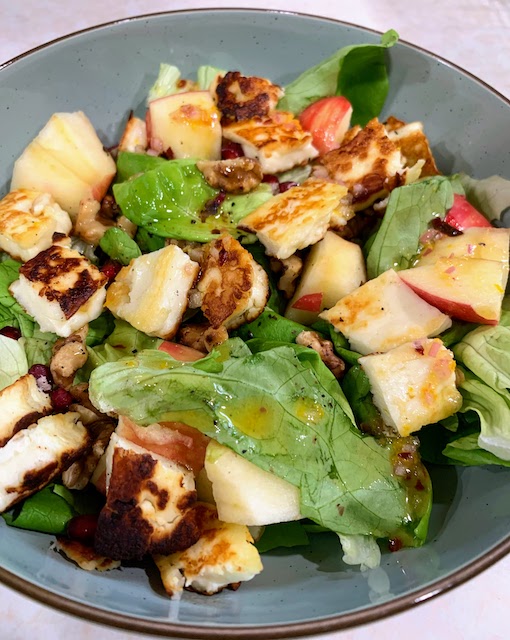
The apple was not as sweet as the persimmon, but it added a bit of crunch.
A hat tip to Julia
Julia Child once said, “One of the secrets, and pleasures, of cooking is to learn to correct something if it goes awry; and one of the lessons is to grin and bear it if it cannot be fixed.”2
My plan to prepare the salad went slightly awry, but it was easily corrected. And I learned that this salad can be enjoyed with different kinds of fruit. We’ll try the mango version shortly, when the fruit is ripe. And maybe a variation with cantaloupe in the spring. So pick a sweet fruit and give it a try!
Now if you’ll excuse me, I’ve got some Substacks to read.
Until next time ,
Mary
The Cook

What new flavors have you discovered recently? Got a new recipe that worked for you? Leave us your suggestions in the comments below or via the Contact Us form.
- This is a direct link to bookshop.org. If you buy a book from them, you can designate that a portion of the sale price be given to an independent bookstore of your choice. Yes, you’ll pay a bit more than buying at Amazon, but the difference benefits independent bookstores, not a billionaire. We do not receive any affiliate payment if you buy a copy. If that changes in the future, we’ll let you know. ↩︎
- From “My Life in France” by Julia Child with Alex Prud’homme, page 242. (Another link to bookshop.org.) ↩︎

Mike, as you know I’m not an easy person when it comes to judging a dish or food in general. But Mary’s recipe made me very curious and so, I decided to stock up on all the ingredients listed to try this culinary proposal. However, there is one important piece of information missing: which wine goes best with this dish?
Livio,
Mary here. I hope by now you have been able to enjoy the salad. We are in the middle of DRY January (only 13 more days to go) but I think a crisp white would do just fine or maybe a light bodied red, or a rose or even a Prosecco. Okay it is obvious that I am obsessing over any type of wine. Let us know what you pick! Miss you my friend.
Yes, to answer directly, we have tasted persimmons! We probably had our first taste about the same time you discovered these gems. The veg and fruit stall at o mercado 31 janeiro where the folks are from Mozambique had them and, as they sometimes do with something new, they offered us a taste and the rest was, well, not quite that lovely salad with haloumi, but we did love them! Alas, we haven’t seen them there since . . . Anyway, bom ano novo!
Keep looking David. I’ve heard from a couple of people in Portugal who have found them. You and Sarah are such adventurous eaters. I don’t think you will be disappointed if you can find the two main ingredients. Give Sarah a hug for me and happy new year to you both.
I’m pretty sure I have seen these at our Mercado, Mary! This is definitely a recipe I’ll want to try even if I have to improvise. Thanks for sharing this and Muito Obrigada for mentioning Our Portugal Journey! – CW
I hope you can find them at the Mercado. They have almost everything there. Boy do I miss it. We don’t have a ton of readers, but you never know when an American might want to escape. I bet you and Nancy are swamped with inquiries. Miss you my friend.
There’s also a smaller grocery/mercado that we go to in Estoril that has a lot of great produce, breads, and meats. I think I’ve seen them there, but definitely at the Cascais Mercado.
I think the next few weeks will be busy ones for me and Nancy. My upcoming article on the 16th is about that.
Miss you and think of you often!
Hugs!
CW
Next year, I’ll go up the road a bit and get some of the delicious persimmons Petals from the Past (https://petalsfromthepast.com/) harvests in the fall. I discovered halloumi last year in Bristol w my brother and live it w a bit of honey and Aleppo. So much fun trying new things!
Love ‘n miss you!
Rosa,
I had no idea that you had persimmons in Alabama. Now that I think about it, it totally makes sense. Using honey and Aleppo on halloumi sounds just about perfect.
Love and miss you my friend.
Seems like a great recipe to try. We loved eating haloumi cheese in Greece and now I use it for company. We have a Greek fishing village in tarpon springs Florida that serves it flaming in every restaurant. Delicious. Just pour alcohol over it and light. Something new for you to try. lol. Thanks for the new website to check out too.
Alice, I just thought I had never had halloumi, but I have had flaming cheese in a Greek restaurant. I’ll have to try it for myself. Thanks for the idea.
We actually have all the ingredients in our refrigerator right now. Excited to try this one…Thanks
That’s what I call a well stocked refrigerator. I hope you enjoy it as much as we did.